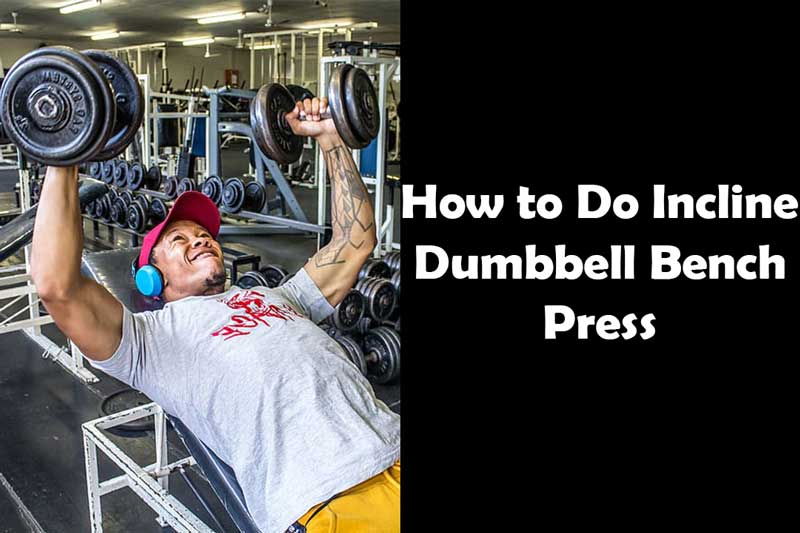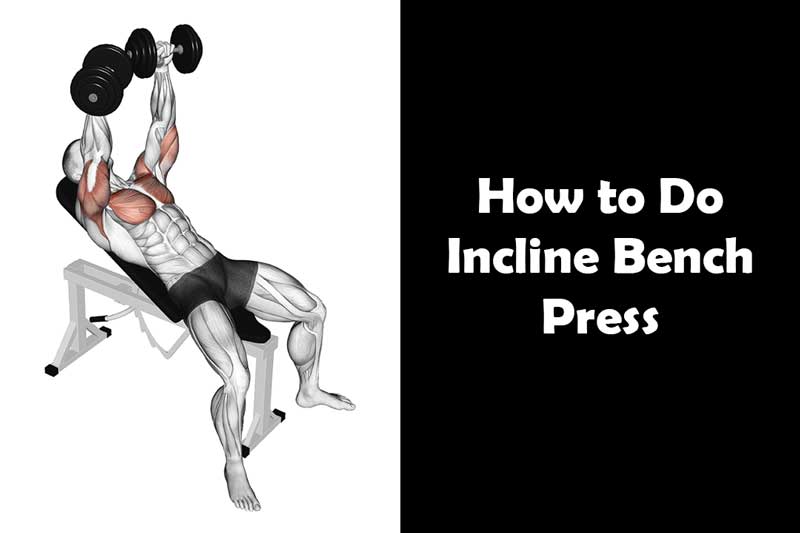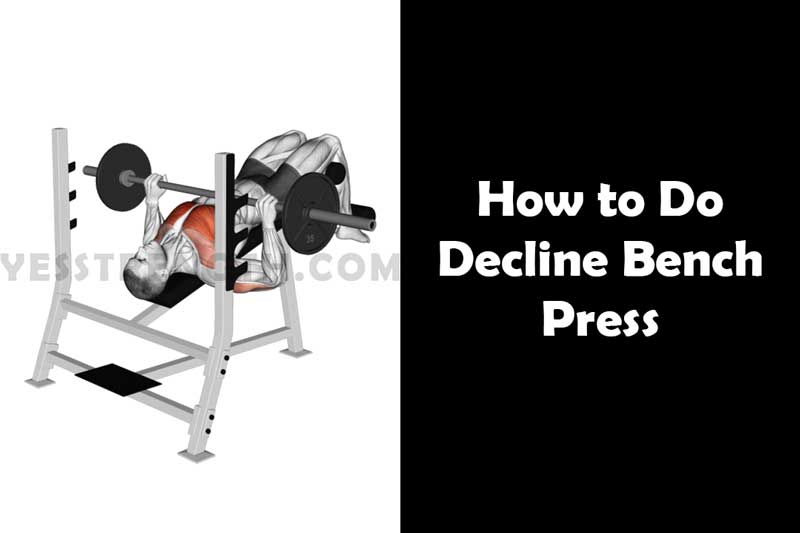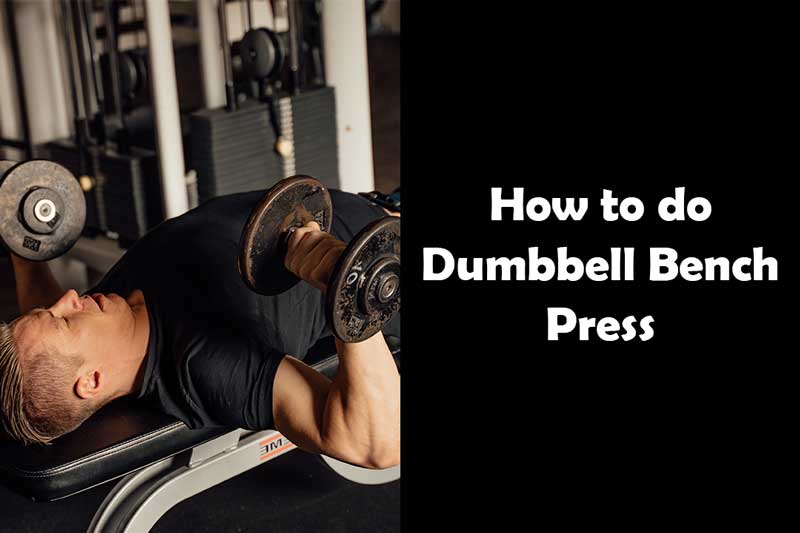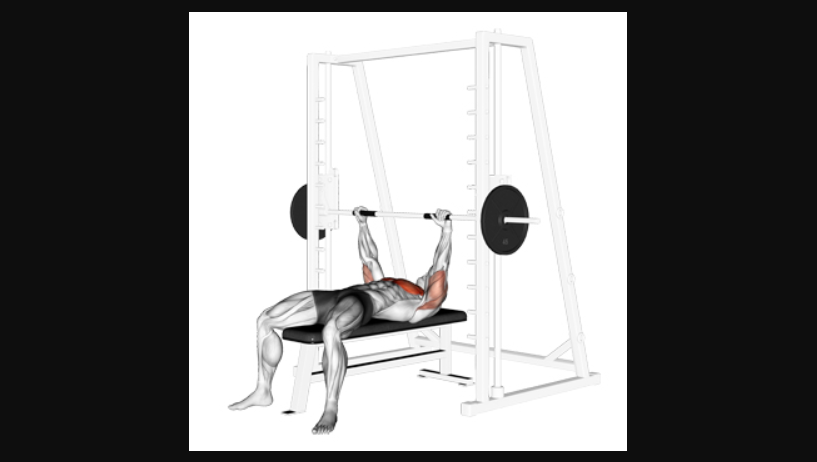When it comes to strength training and building a powerful upper body, especially the upper chest, the incline dumbbell bench press is an excellent exercise to add to your routine. This compound movement targets the chest, shoulders, and triceps while also engaging various stabilizing muscles.
Whether you’re a fitness enthusiast or a seasoned athlete, mastering the incline dumbbell bench press can yield significant benefits. In this article, we will guide you through the proper technique and execution of this exercise, along with its variations and the benefits it offers.
Understanding the Incline Dumbbell Bench Press
1) What is the Incline Dumbbell Bench Press?
The incline dumbbell bench press is a variation of the traditional bench press, where the bench is set at an incline of around 30 to 45 degrees. Instead of a barbell, dumbbells are used, providing more freedom of movement and allowing each arm to work independently. Other forms are flat dumbbell bench press, decline dumbbell bench press.
This exercise primarily targets the upper chest, shoulders, and triceps, making it a valuable addition to any upper body workout routine.
2) Why Should You Include Incline Dumbbell Bench Press in Your Workout Routine?
The incline dumbbell bench press offers several advantages over other chest exercises. Since it targets the upper chest, it helps create a balanced and aesthetic look to the chest muscles.
Additionally, the use of dumbbells promotes better muscle activation, as each side of the body must work equally to lift the weights. This helps in reducing muscle imbalances and enhancing overall upper body strength.
Proper Form and Technique
1. Setting Up the Incline Bench
Before starting the exercise, ensure the incline bench is set at the desired angle. A 30 to 45-degree incline is ideal for targeting the upper chest effectively.
2. Choosing the Right Dumbbells
Select dumbbells that allow you to perform the exercise with proper form. It is crucial to start with a weight that challenges you but is manageable, especially if you are new to this exercise.
3. Body Positioning and Grip
First, sit on the incline bench with your feet flat on the ground. Then, keep your back and head against the bench, maintaining a natural arch in your lower back. Then, grasp the dumbbells with an overhand grip, positioning them at shoulder level with your palms facing forward.
4. Executing the Press
Inhale and lower the dumbbells in a controlled manner to your upper chest, keeping your elbows at a 90-degree angle.
Pause for a moment, then exhale as you push the dumbbells back up to the starting position. Avoid locking your elbows at the top and maintain a slight bend throughout the movement.
Benefits of the Incline Dumbbell Bench Press
1) Strengthens Upper Body Muscles
The incline dumbbell bench press is a powerful compound exercise that targets multiple muscle groups in the upper body. The primary muscles worked during this exercise are the pectoralis major (chest), anterior deltoids (front shoulders), and triceps. By engaging these major muscle groups, the incline dumbbell bench press helps increase overall upper body strength.
2) Enhances Stabilization
Unlike barbell bench presses, the incline dumbbell bench presses require each arm to work independently. This demands more stability and coordination from your core and stabilizing muscles, such as the serratus anterior and rotator cuff muscles. As a result, these muscles become stronger, contributing to better overall body stability and balance.
3) Reduces Muscle Imbalances
Many people tend to have imbalances in their chest and shoulder muscles, with one side stronger or more developed than the other.
The use of dumbbells in the incline bench press allows each arm to work separately, eliminating the possibility of one side compensating for the other.
So, this helps address and correct muscle imbalances, leading to a more balanced and aesthetically pleasing physique.
4) Increases Upper Chest Development
The incline angle of the bench places greater emphasis on the upper chest (clavicular portion of the pectoralis major).
This is an area that can be challenging to target with other exercises. By regularly incorporating incline dumbbell bench presses into your routine, you can build a well-rounded and full-looking chest.
5) Promotes Better Muscle Activation
Dumbbell exercises, in general, require more muscle activation for stabilization compared to barbell exercises.
Since each arm works independently, the incline dumbbell bench press force both sides of your body to work equally.
This balanced activation enhances muscle symmetry and prevents one side from becoming dominant over the other.
6) Allows Natural Shoulder Movement
The fixed barbell path in traditional bench presses might cause discomfort or strain on the shoulders for some individuals.
The incline dumbbell bench press allow a more natural range of motion, reducing the risk of shoulder issues while still effectively targeting the upper chest and shoulders.
7) Improves Athletic Performance
Strong chest and shoulder muscles are vital for various athletic activities, such as throwing, pushing, and lifting.
The incline dumbbell bench presses can enhance upper body strength and power, further contributing to better athletic performance in various sports.
8) Versatility and Home Workout Friendly
Incline dumbbell bench presses can be performed with a simple bench and dumbbells, making them a versatile exercise that can be done at home or in the gym.
Also, this convenience allows individuals to continue their training even without access to elaborate gym equipment.
9) Prevents Plateau and Keeps Training Interesting
Introducing variation in your workout routine is essential to prevent training plateaus. Furthermore, including the incline dumbbell bench presses adds diversity and excitement to your upper body workouts, which can help keep you motivated and engaged in your fitness journey.
10) Suitable for All Fitness Levels
The incline dumbbell bench presses can be adapted to suit different fitness levels. Beginners can start with lighter weights and gradually increase resistance as they gain strength and confidence. However, more advanced individuals can challenge themselves by incorporating variations and heavier dumbbells.
Muscles worked during the incline dumbbell bench press:
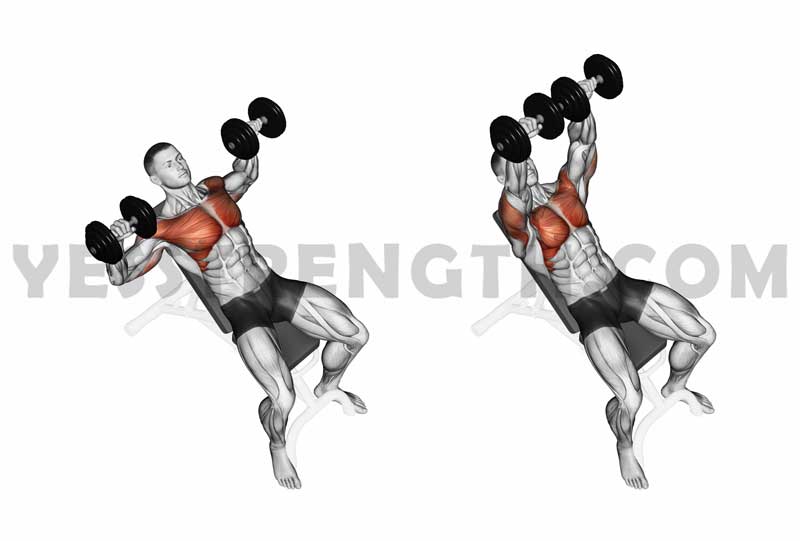
The incline dumbbell bench press mainly targets three muscles in your upper body:
1) Chest Muscles (Pecs)
These are the big muscles in your chest that get stronger and more defined when you do the exercise.
2) Shoulder Muscles (Front Delts)
The front part of your shoulders also gets worked during this exercise.
3) Triceps
These are the muscles at the back of your upper arms, and they also get activated during inclined dumbbell bench press.
In addition to these main muscles, other smaller muscles in your core, upper back, and shoulders also help stabilize your body during the exercise. This is why this amazing upper chest exercise is a great all-around upper body exercise!
Common Mistakes to Avoid
1. Arching the Back too much
One common mistake is arching the back excessively, which can lead to injury. So, keep your upper back firmly pressed against the bench and lower back a little arched throughout the exercise.
2. Flaring Elbows Outward
Allowing your elbows to flare outward shifts the emphasis away from the chest. Instead, keep your elbows at a 45-degree angle to maximize chest activation.
3. Using Excessive Momentum
Swinging the dumbbells up using momentum reduces the effectiveness of the exercise. So, it’s better to focus on a slow and controlled movement to fully engage the targeted muscles.
Variations of the Incline Dumbbell Bench Press
1. Single-Arm Incline Dumbbell Press
This variation involves performing the exercise with one arm at a time, providing an additional challenge to your core and stabilizing muscles. In addition, it can help you concentrate even more on one side and then on the other side. Great for achieving evenness on both sides.
2. Neutral Grip Incline Dumbbell Press
Using a neutral grip (palms facing each other) during the press can reduce strain on the shoulders and place more emphasis on the upper chest.
3. Slow Eccentric Incline Press
Emphasize the eccentric (lowering) phase of the exercise by lowering the dumbbells slowly, which increases time under tension and promotes muscle growth.
Incorporating the Incline Dumbbell Bench Press into Your Workout Routine
1. Frequency and Repetitions
Include the incline dumbbell bench presses in your upper body workouts 2-3 times per week, performing 3-4 sets of 8-12 repetitions.
2. Combining with Other Exercises
To create a well-rounded upper body workout, combine the incline dumbbell bench presses with exercises targeting different muscle groups, such as rows, lateral raises, and triceps dips.
Safety Precautions and Tips
1. Warming Up Before the Workout
Always warm up before performing the incline bench press with dumbbells. This helps prevent injuries and prepares your muscles for the upcoming workout.
2. Consulting a Fitness Trainer
If you are new to this exercise or strength training, consider seeking guidance from a certified fitness trainer to ensure proper form and technique.
Conclusion
The incline dumbbell bench press is a valuable addition to your upper body workout routine, offering various benefits for muscle strength and balance. By understanding the correct form and execution of this exercise, you can maximize its effectiveness and minimize the risk of injury. So, if you want to develop a powerful and well-defined upper body, include the incline bench press with dumbbells in your fitness regimen and watch your strength soar.
Frequently Asked Questions (FAQs)
1. Can the Incline Dumbbell Bench Press help build muscle mass?
Yes, the incline dumbbell bench press is an effective exercise for building muscle mass in the chest, shoulders, and triceps.
2. Is the Incline Dumbbell Bench Press suitable for beginners?
While beginners can perform the incline dumbbell bench presses, it’s essential to start with lighter weights and focus on proper form.
3. How often should I do the Incline Dumbbell Bench Press in a week?
For optimal results, incorporate the incline dumbbell bench presses into your routine 1-2 times per week.
4. Can women benefit from doing the Incline Dumbbell Bench Press?
Absolutely! The incline dumbbell bench press is beneficial for both men and women looking to strengthen their upper bodies.
5. Are there any alternatives to the Incline Dumbbell Bench Press for chest development?
Yes, some alternative exercises for chest development include the barbell bench press, push-ups, and machine chest presses.

